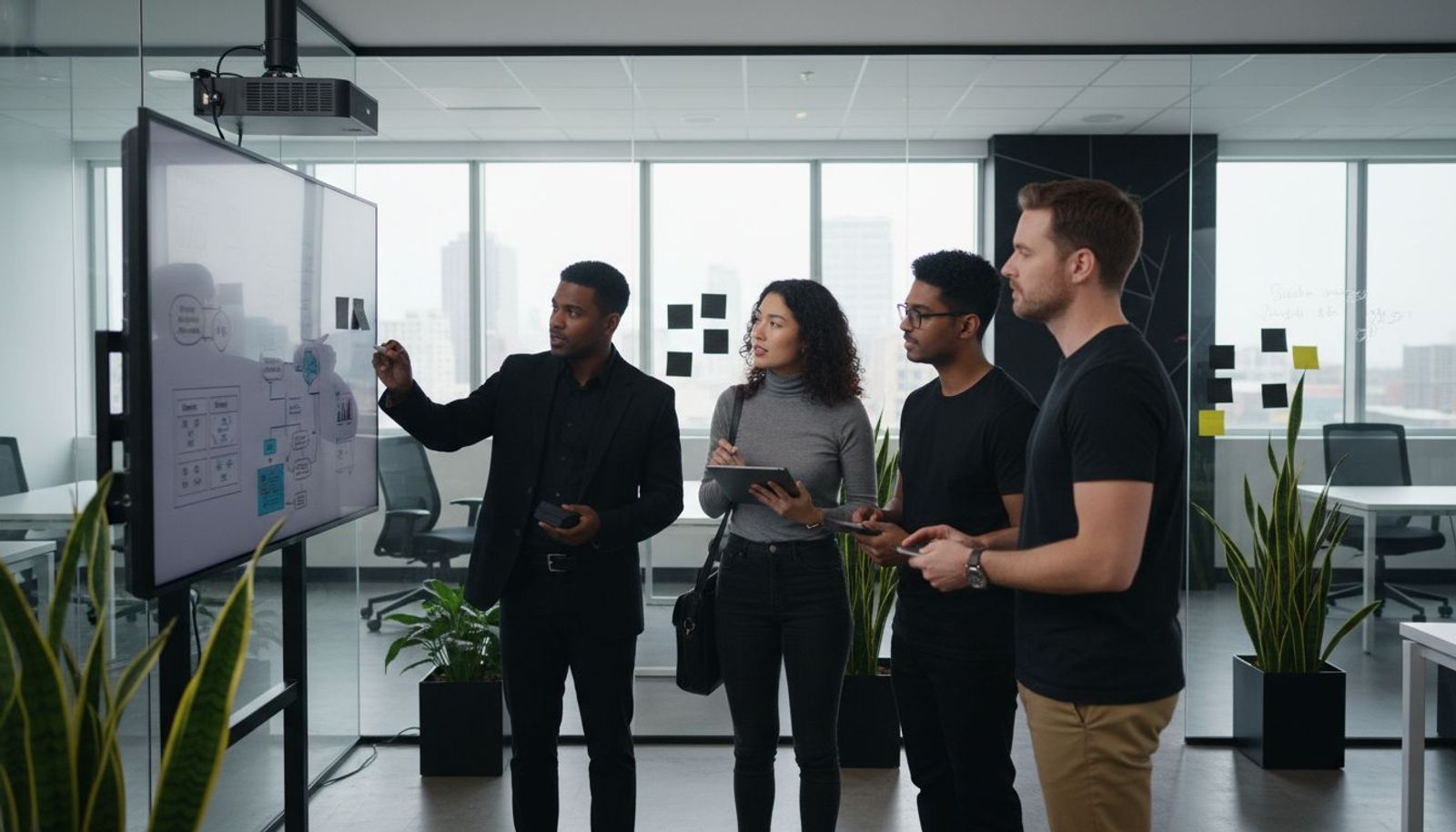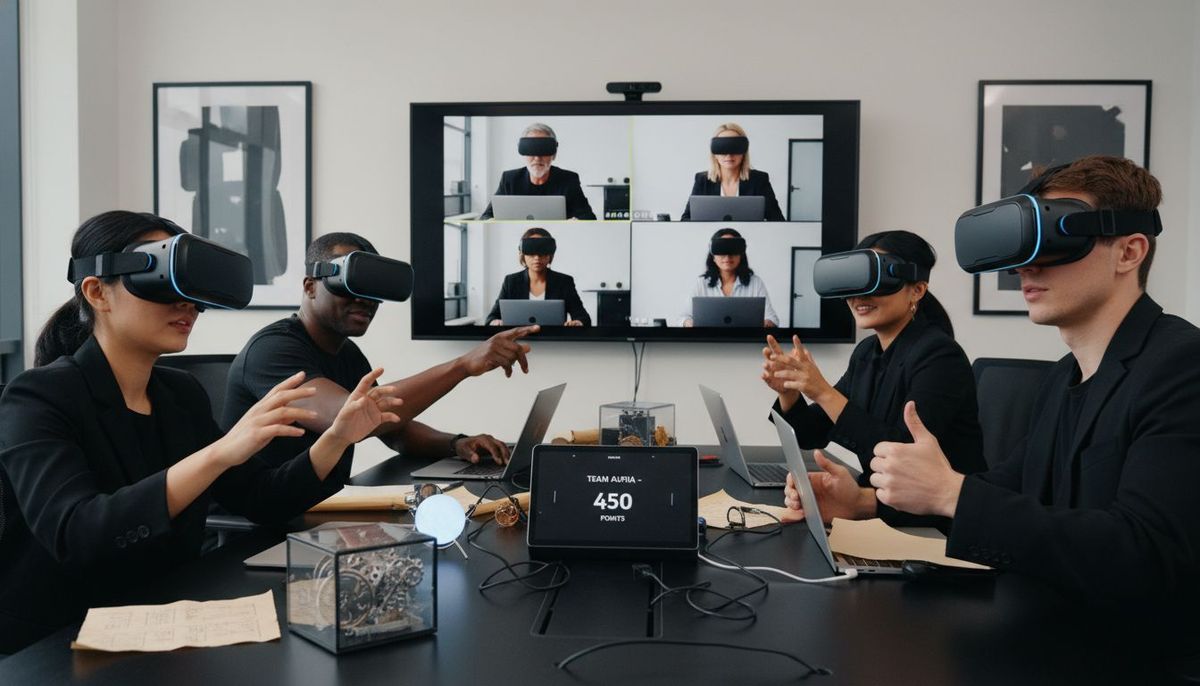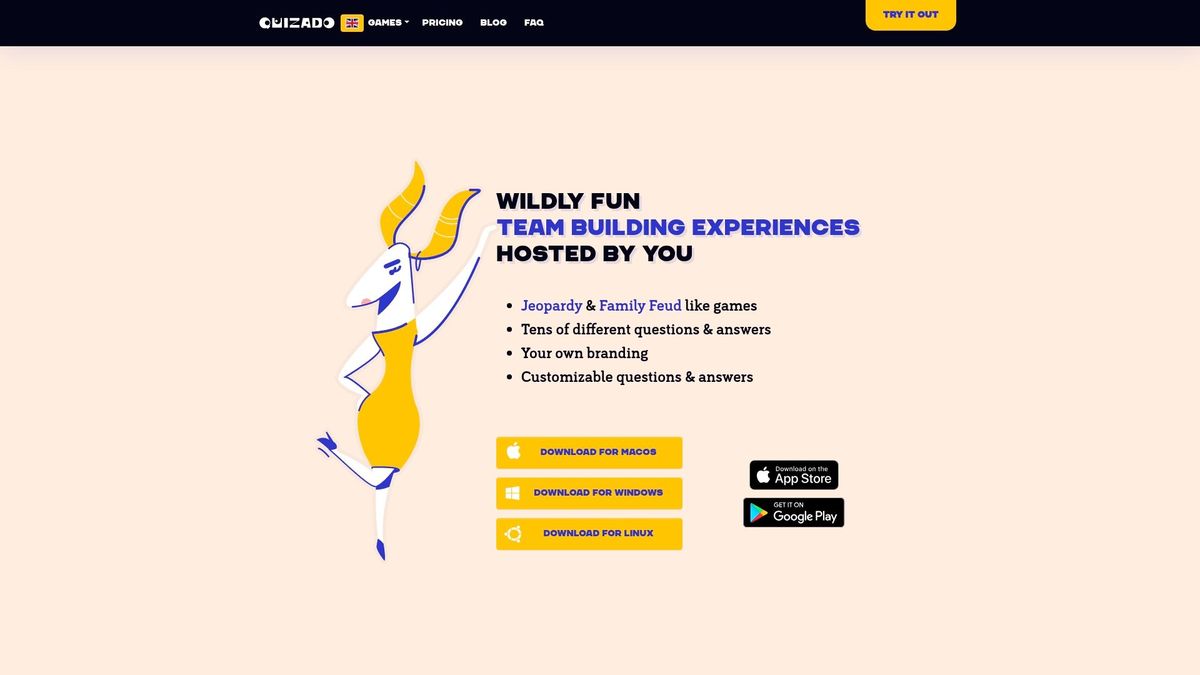Team-Building Best Practices 2025: Complete Guide
October 30, 2025

Did you know that over 70 percent of workplace teams struggle with clear communication in today’s fast-changing work world? Team building is no longer about simple get-togethers, but about forming strong, goal-driven groups ready to tackle new challenges. As workplaces change in 2025, understanding the modern science behind effective team dynamics has never been more important for both leaders and team members who want to drive real results together.
Table of Contents
- Defining Team-Building In 2025 Workplaces
- Types Of Team-Building Activities And Formats
- Leveraging Digital And In-Person Team Games
- Roles, Responsibilities, And Measuring Success
- Critical Pitfalls And How To Avoid Them
Key Takeaways
| Point | Details |
|---|---|
| Modern Team Building Focus | Effective team building in 2025 prioritizes meaningful connections and aligns team dynamics with organizational objectives through personalized engagement strategies. |
| Tailored Activity Formats | Organizations are shifting towards dynamic, immersive team-building activities that cater to diverse communication styles and professional backgrounds. |
| Hybrid Team Games | Successful team-building games integrate digital and in-person experiences to foster collaboration among remote and co-located team members. |
| Critical Success Factors | Establishing role clarity, goal alignment, and continuous feedback are essential for creating resilient teams capable of thriving in a complex workplace landscape. |
Defining Team-Building in 2025 Workplaces
Team building has evolved dramatically from traditional corporate retreats to strategic engagement methods that purposefully align team dynamics with organizational objectives. Modern team building now transcends simple social activities, focusing instead on creating meaningful connections that drive performance, collaboration, and collective problem solving.
According to research from Understanding Team Building Concepts, contemporary team building involves several critical components:
- Establishing clear communication pathways
- Defining individual and collective roles
- Creating psychological safety within work environments
- Developing collaborative problem solving skills
- Reducing workplace role ambiguity
In 2025, successful team building recognizes that diverse teams require nuanced approaches that respect individual strengths while promoting collective achievement. This means moving beyond one-size-fits-all activities toward personalized engagement strategies that consider team members' unique communication styles, professional backgrounds, and interpersonal dynamics.
The ultimate goal remains consistent: transforming groups of individuals into high-performing, interconnected units capable of navigating complex workplace challenges with agility and mutual understanding. By intentionally designing experiences that foster genuine connections and shared understanding, organizations can create resilient teams prepared for the dynamic work environments of the future.
Types of Team-Building Activities and Formats
Team-building activities in 2025 have transformed from traditional approaches into dynamic, immersive experiences that challenge teams to collaborate in innovative ways. Emerging formats now blend technology, creativity, and psychological insights to create meaningful engagement opportunities that go far beyond simple icebreaker exercises.
According to research from 7 Essential Team Engagement Activities, modern team-building activities now encompass diverse formats designed to address multiple organizational needs:
- Virtual Reality Challenges: Immersive digital experiences that test problem solving skills
- Collaborative Art Projects: Creative activities that encourage non-verbal communication
- Outdoor Adventure Programs: Physical challenges that build trust and resilience
- Diversity and Inclusion Workshops: Structured conversations promoting mutual understanding
- Music and Rhythm Circles: Interactive experiences that synchronize team dynamics
Here's a comparison of common team-building activity formats in 2025:
| Activity Format | Key Focus | Engagement Type |
|---|---|---|
| Virtual Reality Challenges | Problem solving | Digital, Immersive |
| Collaborative Art Projects | Non-verbal communication | In-person, Creative |
| Outdoor Adventure Programs | Trust & resilience | Physical, Outdoor |
| Diversity & Inclusion Workshops | Mutual understanding | Structured, Conversational |
| Music and Rhythm Circles | Team synchronization | Interactive, Experiential |
In 2025, successful team-building recognizes that different team compositions require tailored approaches. Organizations are moving away from generic activities toward personalized experiences that consider team members' unique strengths, communication styles, and professional backgrounds. This might mean designing activities that simultaneously challenge introverts and extroverts, technical and creative professionals, or multi-generational team members.
The ultimate goal remains consistent: creating experiences that transform individual contributors into cohesive, high-performing units. By carefully selecting activities that engage multiple dimensions of team interaction - emotional, intellectual, and collaborative - organizations can build resilient teams capable of navigating complex workplace challenges with creativity and mutual respect.

Leveraging Digital and In-Person Team Games
In 2025, successful organizations recognize that team-building games must seamlessly blend digital and physical experiences to accommodate diverse workplace environments. Hybrid game strategies have emerged as a powerful approach to creating meaningful team connections, regardless of whether team members are co-located or working remotely.
According to 8 Engaging Online Team Building Games, modern team games now incorporate multiple engagement formats:
- Virtual Escape Rooms: Collaborative digital problem-solving challenges
- Online Trivia Competitions: Knowledge-based team interactions
- Blindfold Maze Challenges: Trust-building physical exercises
- Digital Scavenger Hunts: Interactive experiences across physical and virtual spaces
- Synchronized Skill Challenges: Competitive activities bridging remote and in-person team members
The most effective team games in 2025 intentionally design experiences that transcend traditional boundaries. Organizations are moving beyond one-dimensional activities to create multilayered game experiences that simultaneously challenge cognitive skills, emotional intelligence, and collaborative capabilities. This might involve combining virtual reality simulations with physical team obstacle courses or integrating real-time digital communication tools into traditional team-building exercises.
Ultimately, the goal remains consistent: creating engaging, inclusive experiences that transform individual contributors into cohesive, high-performing teams.
By thoughtfully selecting games that adapt to different team compositions, communication styles, and technological capabilities, organizations can build resilient, connected teams capable of thriving in an increasingly complex workplace landscape.
Roles, Responsibilities, and Measuring Success
In 2025, successful team building transcends traditional organizational structures by creating dynamic, fluid frameworks that empower individual contributors while maintaining clear accountability. Organizational alignment has become a sophisticated process of matching individual strengths with collective goals, recognizing that effective teamwork requires both structured expectations and adaptive capabilities.
Understanding Defining Team Building Success highlights several critical components for establishing effective team roles and measuring performance:
- Role Clarity: Precisely defining individual responsibilities
- Goal Alignment: Connecting personal objectives to team outcomes
- Performance Metrics: Establishing quantifiable success indicators
- Skill Mapping: Identifying and leveraging team members' unique capabilities
- Continuous Feedback: Creating responsive evaluation mechanisms
Modern organizations are moving beyond static job descriptions toward more agile role definitions that allow team members to flex their capabilities across different projects and challenges. This approach requires sophisticated performance measurement systems that assess not just individual output, but collaborative potential, adaptability, and cross-functional contribution.
Ultimately, the most successful teams in 2025 will be those that balance structured accountability with genuine flexibility. By creating transparent role expectations, implementing nuanced performance evaluation frameworks, and fostering an environment of continuous learning and adaptation, organizations can build resilient teams capable of navigating increasingly complex workplace challenges with creativity and collective intelligence.
Critical Pitfalls and How to Avoid Them
Team-building initiatives often fail not because of poor intentions, but due to fundamental misunderstandings about group dynamics and individual motivations. Organizational transformation requires a nuanced approach that anticipates and proactively addresses potential challenges before they derail collaborative efforts.
According to research on team building challenges, organizations frequently encounter several critical pitfalls:
- Communication Breakdowns: Misaligned expectations and unclear communication channels
- Resistance to Change: Individual and collective psychological barriers
- Unresolved Interpersonal Conflicts: Task, process, and relationship tensions
- Skill Mismatch: Inadequate training or misaligned team member capabilities
- Motivation Disparities: Varying levels of engagement and commitment
Successful teams in 2025 recognize that preventing these pitfalls requires more than superficial team-building exercises. They implement comprehensive strategies that address root causes, such as creating psychologically safe environments, developing robust communication protocols, and designing flexible frameworks that accommodate individual differences while maintaining collective momentum.
Ultimately, avoiding team-building pitfalls demands a holistic approach that balances structured interventions with genuine human understanding. By cultivating emotional intelligence, providing targeted skill development, and creating transparent mechanisms for feedback and conflict resolution, organizations can transform potential obstacles into opportunities for growth, learning, and enhanced team performance.
Boost Your Team-Building Success with Interactive Quiz Games
Building a cohesive and high-performing team in 2025 requires thoughtful approaches that address challenges like communication breakdowns and motivation disparities. The article highlights the importance of tailored engagement and clear role clarity to avoid common pitfalls and enhance collaboration. If your goal is to create psychologically safe and energized teams who thrive on connection and shared success, embracing flexible, interactive methods is key.

Discover how customizable team-building game experiences can transform your group dynamics. Quizado.com offers engaging and easy-to-use quiz games inspired by popular shows, designed specifically for remote and in-person teams. With features such as personalized branding, team configuration, and a rich question bank, your team can enjoy meaningful, fun interactions that boost trust and collaboration now. Visit Quizado and start creating memorable team-building moments today.
Frequently Asked Questions
What are the essential components of team-building in 2025?
The essential components of team-building in 2025 include establishing clear communication pathways, defining individual roles, creating psychological safety, developing collaborative problem-solving skills, and reducing workplace role ambiguity.
How do modern team-building activities differ from traditional ones?
Modern team-building activities focus on immersive, engaging experiences such as virtual reality challenges, outdoor adventure programs, and collaborative art projects, whereas traditional activities often relied on simple social gatherings or retreats.
What are hybrid team-building games, and why are they important?
Hybrid team-building games blend digital and in-person experiences to create meaningful connections among team members, accommodating various workplace environments and ensuring inclusivity regardless of physical location.
How can organizations measure the success of their team-building initiatives?
Organizations can measure the success of team-building initiatives by establishing clear role clarity, aligning goals, creating performance metrics, mapping team members' skills, and implementing continuous feedback mechanisms.



